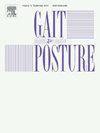障碍穿越中的步态表现:虚拟信息对光学头戴式显示器的影响
IF 2.2
3区 医学
Q3 NEUROSCIENCES
引用次数: 0
摘要
光学头戴式显示器(ohmd)的使用已经增长,使虚拟信息能够覆盖现实世界。然而,戴着OHMD走路可能会降低态势感知能力,增加事故风险,尤其是在障碍物导航时。本研究调查了佩戴OHMD对此类运动中步态的影响。方法对20名健康成人在无OHMD、有OHMD但无虚拟信息(OC_HMD)和有OHMD显示虚拟内容(OC_AR)三种情况下的过障行为进行分析。收集参与者的步态数据。检查的参数包括步态速度、步幅、步宽、脚趾间隙和前脚和后脚的脚位置。ResultsThe结果表明阅读虚拟信息OHMD减少进场速度(1.70 ±0.25 m / s)和步幅(1.26 ±0.14 m),而仅仅穿着OHMD影响跨越速度(1.36 ±0.20 m / s),进一步减少虚拟信息时显示。无论虚拟信息,脚趾头间隙(210.79 ±35.38 mm的领导,和228.89 ± 落后55.61 毫米)和拖脚位置增加OHMD-wearing条件(258.53 ±46.25 OC_HMD和228.38毫米 ±56.56 OC_AR毫米)。研究结果表明,无论显示是否激活,佩戴OHMD都会影响关键的步态参数,如步行速度、步幅、脚趾间隙和足部位置。未来针对不同环境的OHMD设计应考虑虚拟信息的影响和设备对步态性能的影响。本文章由计算机程序翻译,如有差异,请以英文原文为准。
Gait performance in obstacle crossing: Impact of virtual information on an optical head-mounted display
Background
The use of optical head-mounted displays (OHMDs) has grown, enabling virtual information to overlay the real world. However, walking with an OHMD may reduce situational awareness and increase accident risk, especially during obstacle navigation. This study investigates the effects of wearing an OHMD on gait during such movement.
Method
Analyses were conducted on twenty healthy adults under three conditions: Obstacle crossing without an OHMD, with an OHMD but no virtual information (OC_HMD), and with an OHMD displaying virtual content (OC_AR). Participants' gait data were collected. The parameters examined included gait speed, stride length, step width, and the toe-off clearance and foot placement of both the leading and trailing feet.
Results
The results showed that reading virtual information on the OHMD reduced approach speed (1.70 ± 0.25 m/s) and stride length (1.26 ± 0.14 m), while simply wearing the OHMD affected crossing speed (1.36 ± 0.20 m/s), which decreased further when virtual information was displayed. Regardless of the virtual information, toe-off clearance (210.79 ± 35.38 mm for leading, and 228.89 ± 55.61 mm for trailing) and trailing foot placement increased in both OHMD-wearing conditions (258.53 ± 46.25 mm for OC_HMD and 228.38 ± 56.56 mm for OC_AR).
Discussions and conclusion
The findings suggested that wearing an OHMD, regardless of display activation, affected key gait parameters such as walking speed, stride length, toe-off clearance, and foot placement. Future OHMD designs for different environments should consider both the effect of virtual information and the mere presence of the device on gait performance.
求助全文
通过发布文献求助,成功后即可免费获取论文全文。
去求助
来源期刊

Gait & posture
医学-神经科学
CiteScore
4.70
自引率
12.50%
发文量
616
审稿时长
6 months
期刊介绍:
Gait & Posture is a vehicle for the publication of up-to-date basic and clinical research on all aspects of locomotion and balance.
The topics covered include: Techniques for the measurement of gait and posture, and the standardization of results presentation; Studies of normal and pathological gait; Treatment of gait and postural abnormalities; Biomechanical and theoretical approaches to gait and posture; Mathematical models of joint and muscle mechanics; Neurological and musculoskeletal function in gait and posture; The evolution of upright posture and bipedal locomotion; Adaptations of carrying loads, walking on uneven surfaces, climbing stairs etc; spinal biomechanics only if they are directly related to gait and/or posture and are of general interest to our readers; The effect of aging and development on gait and posture; Psychological and cultural aspects of gait; Patient education.
 求助内容:
求助内容: 应助结果提醒方式:
应助结果提醒方式:


